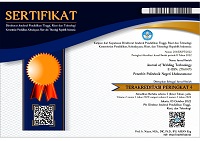Hardness Analysis of Weld Metal Electrode Low Hydrogen Potassium E7016 and E7018
Abstract
Electrodes for the Manual Metal Arc (MMA) welding process or welding electrodes are classified based on the type of coating which is informed by the last digit code of the electrode. Electrodes E7016 and E7018 are basic types of electrodes with a Low Hydrogen Potassium coating type which are widely used in welding heavy construction equipment and piping. This electrode has a minimum tensile value of 70 ksi (480 MPa) with a carbon content of 0.07% for E7018 and 0.08% for E7016. The difference in carbon content in the composition of the electrode will determine the hardness value of the resulting weld. In use in the field these two electrodes are often recommended and can even be exchanged according to the assumption that the minimum tensile value is relatively the same between the two electrodes. However, due to the difference in carbon content, it will affect the hardness of the weld (weld metal) after welding. Many studies have been carried out to determine the mechanical properties of the welded joints using these electrodes, but research on the specific mechanical properties of the welds of the two electrodes is very rarely carried out. The test method is carried out by making 2 test specimens each for currents of 80A, 100A, and 120A using E7016 and E7018 electrodes with a diameter of 3.2mm. The material used is SA.36. The hardness test was carried out using the Rockwell-C (HRC) method. The test results show that the hardness value of the basic low hydrogen potassium electrode E7018 has a higher hardness value than E7016 for the same current. At currents of 80A, 100A, and 120A, there was an increase in the hardness of the E7018 weld metal against E7016 by 2.0% each; 9.8%; and 6.7%. The highest hardness value is found at 80A of 42.3HRC for the E7018 electrode, and 41.5 HRC for the E7016 electrode. In E7016 the increase in current causes a decrease in hardness level of 8.2% from 80A to 100A; 12.3% from 100A to 120A. In E7018 the increase in current causes a 1.2% decrease in hardness from 80A to 100A; 14.7% from 100A to 120A
Keywords
Full Text:
PDFReferences
A. Azwinur, A. S. Ismy, R. Nanda, and F. Ferdiyansyah, “Pengaruh arus pengelasan SMAW terhadap kekuatan sambungan las double lap joint pada material AISI 1050,” J. Weld. Technol., vol. 2, no. 1, pp. 1–7, 2020.
A. M. Pope and S. Liu, “Hydrogen content of underwater wet welds deposited by rutile and oxidizing electrodes,” American Society of Mechanical Engineers, New York, NY (United States), 1996.
W. Handbook, “Kobelco Welding Handbook Welding Consumables And Processec,” Shinigawa. Japan: Kobe Steel, LTD Welding Bussines, 2011.
M. A. Bodude and I. Momohjimoh, “Studies on effects of welding parameters on the mechanical properties of welded low-carbon steel,” J. Miner. Mater. Charact. Eng., vol. 3, no. 03, p. 142, 2015.
B. A. Wicaksono, N. Syahroni, and Y. Mulyadi, “Experimental Study of Electrode Variation Effect on Connection Strength for Underwater Welding,” Int. J. Offshore Coast. Eng., vol. 6, no. 2, p. pp-72, 2022.
S. A. Adzora, E. E. Nnukab, and K. C. Nnakwob, “Effect of welding consumable on mechanical properties of micro-alloyed steel weldment,” Int. J. Innov. Sci. Res. Technol., vol. 4, no. 6, pp. 419–425, 2019.
B. H. Chang and Y. Zhou, “Numerical study on the effect of electrode force in small-scale resistance spot welding,” J. Mater. Process. Technol., vol. 139, no. 1–3, pp. 635–641, 2003.
Y. N. I. Saputro, “PENGARUH ARUS PENGELASAN TERHADAP KEKUATAN TARIK SAMBUNGAN LAS SMAW DENGAN ELEKTRODA E 7018,” RESULTAN J. Kaji. Teknol., vol. 13, no. 2, pp. 24–31, 2011.
W. Karmawan et al., “Analisa Kekuatan Variasi Arus Las SMAW Dengan Elektroda E 7018 Bahan Baja ST 42 Terhadap Sifat Mekanis,” J. Mesin Mater. Manufaktur dan Energi, vol. 1, no. 1, pp. 19–23, 2020.
N. Chairul, I. Irzal, M. Mulianti, and H. Nurdin, “PENGARUH VARIASI KUAT ARUS TERHADAP KEKUATAN TARIK HASIL PENGELASAN SMAW PADA BAJA KARBON RENDAH DENGAN ELEKTRODA E-7018,” J. Vokasi Mek., vol. 4, no. 4, pp. 167–172, 2022.
E. Gharibshahiyan, A. H. Raouf, N. Parvin, and M. Rahimian, “The effect of microstructure on hardness and toughness of low carbon welded steel using inert gas welding,” Mater. Des., vol. 32, no. 4, pp. 2042–2048, 2011.
K. Herrmann, Hardness testing: principles and applications. ASM international, 2011.
J. Li and A. K. Soh, “Modeling of the plastic deformation of nanostructured materials with grain size gradient,” Int. J. Plast., vol. 39, pp. 88–102, 2012.
W. L. Chan, M. W. Fu, and J. Lu, “The size effect on micro deformation behaviour in micro-scale plastic deformation,” Mater. Des., vol. 32, no. 1, pp. 198–206, 2011
DOI: http://dx.doi.org/10.30811/jowt.v4i2.3492
Refbacks
- There are currently no refbacks.

This work is licensed under a Creative Commons Attribution-ShareAlike 4.0 International License.
Ciptaan disebarluaskan di bawah Lisensi Creative Commons Atribusi-BerbagiSerupa 4.0 Internasional.
Mailing Address:
Politeknik Negeri Lhokseumawe
Jl. Banda Aceh-Medan
Km. 280,3, Buketrata, Mesjid Punteut, Blang Mangat,
Kota Lhokseumawe, 24301
Propinsi Aceh,
Indonesia























